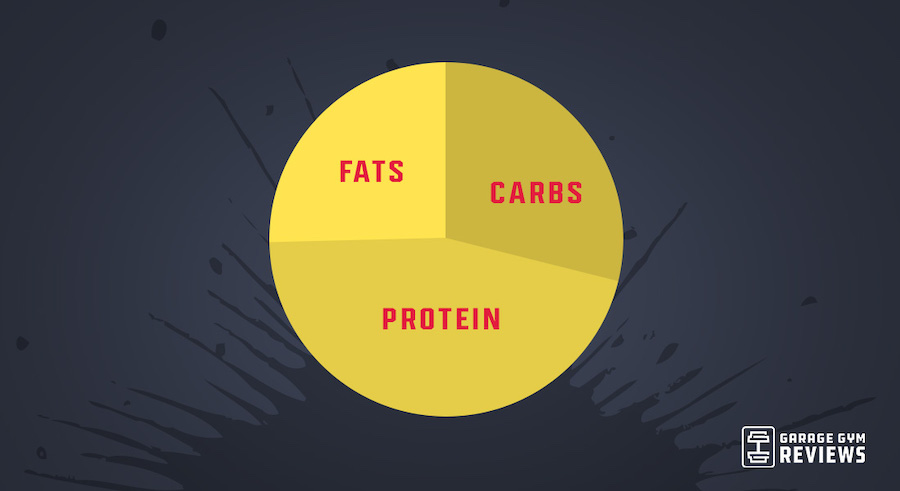If you’re in the fitness sphere, you’ve likely heard all about macros. Heck, you might even be on the IIFYM train already and be more glued to your Lumen than your smartphone.
As nutrition and health nuts, we get it—we get the magic of learning all about diet and what that entails, including how tracking macros can help ignite your athletic potential and shed some unwanted pounds.
But if you’re new to the concept of macros, let’s first clear the air… IIFYM is an acronym for “If It Fits Your Macros.” Secondly, you’ve come to the best spot to learn what macros are, how to count macros for weight loss, and more!
RELATED: Best-tasting protein powder
So if you’re curious about macros, let’s look into the research to see if there’s a magic macro ratio to shoot for.
Medical disclaimer: This article is intended for educational and informational purposes only. It is not intended as a substitute for medical advice. For health advice, contact a licensed healthcare provider.
What Are Macronutrients? Breaking Down Protein, Carbs, and Fat
Macronutrients1, otherwise known as “macros,” are essential nutrients your body needs in large amounts (macro = large) to function optimally. There are three main types of macronutrients—carbohydrates, protein, and fat—and the body needs a combination of these macros to maintain longevity and health.
Each macronutrient has its own unique set of functions, although they all provide the body with energy in the form of calories. Both carbohydrates and protein provide 4 calories per gram while fat provides 9 calories per gram.
Your daily calories and macros depend on various factors like birth sex, age, activity level, and body composition goals. Macros have become widely popular in the fitness world, as counting them can maximize gains while bulking and cutting.
Protein Macros
Speaking of gains, protein is vital to build muscle and is made up of building blocks called amino acids. Protein also supports immune health, hormone production, and, really, overall health.
Each gram of protein provides 4 calories and the 2020-2025 Dietary Guidelines for Americans (DGAs) recommends 10 to 35 percent of calories should come from protein. Research2 further suggests at least 1.2 to 1.6 grams per kilogram (g/kg) of high-quality protein is a more ideal target for achieving optimal health outcomes in adults.
High-protein foods—such as sirloin, chicken breasts, and tilapia—are often animal-based but foods like tofu, nuts, seeds, and legumes are plant-based protein sources. Some of the top-ranked protein powders and protein bars also come in animal and plant-based options.
While non-animal-based proteins such as the best vegan protein powders are a great source for vegans or dairy-free eaters, it should be noted that most vegan-based protein sources (with the exception of soy) lack all 9 essential amino acids to create a complete protein. Always check your product to see that it has a full amino acid profile detailing all EAAs (companies will add complementary proteins to make them a complete protein).
RELATED: Best whey protein

It’s also important to note while most foods contain two—or even all three—of the macronutrients, they are categorized by the macro they are the richest in. For instance, sirloin is rich in protein but also contains some fat. Beans are also a great plant-based protein source, although they also contain carbohydrates.
RELATED: Best protein chips
Carbohydrate Macros
Carbohydrates—also known as carbs—include sugars, starches, and dietary fiber. Carbs are mostly broken down into glucose, a type of sugar, which is immediately used for energy or stored in your liver and muscles as glycogen (the storage form of glucose).
Whereas high-fat ketogenic and low-carb diets have vilified carbohydrates, they are the body’s and brain’s primary fuel source. Carbohydrates also preserve muscle breakdown and fiber-rich carb sources, especially, promote digestive, heart, and metabolic health.
RELATED: Best organic protein powder
Carbohydrates provide 4 calories per 1 gram and the DGAs recommends consuming 45 to 65% of daily calories from carbohydrate sources. Women and men should also aim for 25-38 grams of fiber per day, respectively, with no more than 10% of calories coming from added sugars.
Ideally, you should focus on nutrient-dense and fiber-rich carb sources like whole grains, fruits, vegetables, beans, fruits, and dairy products. You can enjoy “fun foods” on occasion—looking at you, chocolate chip cookies—but ideally should limit refined carb sources like white bread, cookies, cakes, pies, and soft drinks.
Fat Macros
Unless a keto diet advocate, dietary fat is often deemed as “bad,” but rest assured the macronutrient is essential for good health. Dietary fat supports good hormone health, protects the body’s precious organs, and so much more.
The type of fat you consume matters most, as too much saturated and trans fats can increase the risk of heart attack and stroke. Including more unsaturated fatty acids can lower these risks and protect the heart.
Out of the three macronutrients, fats are the most calorically dense and provide 9 calories per gram. The DGAs recommend that 20-35% of daily calories should come from fat, with no more than 10% of calories coming from saturated fat.
Healthy fats are sourced from olive oil, fatty fish, avocado, nuts, and seeds. Some of the best fish oil supplements also provide healthy fats mostly in the form of omega-3 fatty acids.
Alcohol Macros
Because alcohol is not essential to health, and can actually cause more harm than good, alcohol is not technically a macronutrient. But since alcohol does provide calories, specifically 7 calories per 1 gram, it is often clumped with macros.
Because macro dieting (as you’ll soon learn) can be a nutrition-based tool for diet flexibility, it’s still worth noting. Of course, you should practice the concept of moderation, but it can still fit well into a balanced diet and lifestyle.
What Is the Macro Diet?
There is no single and specific macro diet. Instead, a macro diet is any diet approach—like “If It Fits Your Macros (IIFYM)”—that encourages you to track how many carbohydrates, protein, and fat you consume each day.
RELATED: Best protein powder for men
Despite the emphasis on macro tracking, however, you first need to figure out your daily caloric target. After you identify your calorie needs, you can then neatly package those into an identified macronutrient ratio—which is often measured and tracked in grams.
Research1 suggests whether there is a combination of macronutrients that provides optimal health is elusive, though. For example, the animal-based diet of an Alaskan Inuit group was found to comprise 33% protein, 41% fat, and 26% carbohydrate with dental and heart-health benefits. In contrast, the diet of Irish farm workers provided 12% protein, 1% fat, and 87% carbohydrate; this diet was linked to an exceptionally low rate of death from diabetes.
Research suggests whether there is a combination of macronutrients that provides optimal health is elusive.
But before you worry too much about macro ratios, you should decide if following a macro-based approach is right for you.
Macro Diet Pros and Cons
Like most (if not all) diets, there are pros and cons to consider. Of course, these aren’t meant to persuade or discourage you from following a macro diet, but they can help you make a well-informed and educated decision.
Pros:
- Encourages a balanced diet with carbs, protein, and fat
- Provides diet flexibility while helping you stay on track with your diet and health-related goals
- Allows you to check in with your eating patterns
- Helps change body composition, especially with adequate protein in the mix
- Offers diet structure for certain medical conditions, including diabetes where carb content especially needs to be monitored
Cons:
- Some find tracking macros to be tedious and cumbersome
- Can discourage tuning into the body’s natural hunger cues, especially if you hit your macros but still feel hungry
- May cause more stress, especially while dining out and macro breakdowns are not available
- Might spur disordered eating patterns
While you can personally weigh the pros and cons of a macro diet, you should ideally consult with a registered dietitian and/or credentialed nutritionist. They can guide you to an appropriate dietary method to best meet your goals and assist you in calculating your daily macro needs if you take that approach—but it’s also smart to have an understanding of how to calculate and track macros!
Calculating Macros
If interested in or curious about calculating your macros, look no further. Follow the steps below so you can start tracking your daily macros.
1. Determine Your Daily Calorie Needs
While a macro diet focuses on tracking macros, you still need to determine your daily calorie needs first. Because, remember, macronutrients provide the body with energy in the form of calories.
Calorie needs mostly vary based on biological sex, age, and activity level and can be determined using an online calorie calculator or with equations like the Mifflin-St. Jeor (which is actually used in the online calculator). The Mifflin-St. Jeor equation is one of the most popularly used formulas among healthcare professionals and novice calorie trackers alike, as it’s thought to be the most accurate within a 10% error margin.
How to Use the Mifflin-St. Jeor Equation
The first part of the equation estimates your resting metabolic rate (RMR)—the number of calories you essentially burn at rest—and considers biological gender, weight, height, and age:
- Men: calories/day = 10 x weight (kg)* + 6.25 x height (cm)** – 5 x age (y) + 5
- Women: calories/day = 10 x weight (kg) + 6.25 x height (cm) – 5 x age (y) – 161
RELATED: Best protein powder for women
*Convert pounds into kilograms by dividing your weight by 2.2.
**Convert your height into centimeters by getting your height in inches (12 inches in one foot) and then multiplying by 2.54.
After you calculate your estimated BMR, multiply that number by an activity factor:
- Sedentary: 1.2
- Lightly active: 1.375
- Moderately active: 1.55
- Active: 1.725
- Very active: 1.9
This final number represents total daily energy expenditure (TDEE), which is the total number of calories burned per day when activity is factored in. People who want to either lose or gain weight can slightly decrease or increase their calories, although they should do so gradually, or can maintain their weight using their calculated TDEE.
For example, let’s say you are a lightly active, 35-year-old female who weighs 150 pounds and stands 5’7” tall.
RELATED: Best pre-workout for women
- Convert those metrics into kilograms and centimeters:
- 150 pounds/2.2 = 68.2 kg
- 5’7” = 5*12+7 = 67” x 2.54 = 170.2 cm
- Plug ‘n chug your age, weight, and height in the women’s equation:
- 10 x weight (kg) + 6.25 x height (cm) – 5 x age (y) – 161
- 10 x 68.2 kg + 6.25 x 170.2 cm (ht) – 5 x 35 – 161 = 1409 calories
- Remember, use the order of operations using “PEMDAS” (Parentheses, Exponents, Multiplication, Division, Addition, Subtraction) from left to right
- Multiply your estimated BMR by the lightly active activity factor 1.375 to get your estimated TDEE:
- 1409 (your BMR) x 1.375 = 1,936 calories (we’ll round up to 1940 calories/day)
2. Decide On Your Macronutrient Distribution
Now that you have determined your calorie intake needs, you then need to decide on the macronutrient distribution you want to follow. While a dietitian can help you best determine this, we recommend starting with the DGA’s macronutrient recommendations:
- Protein: 10–35% of total calories
- Fat: 20–35% of total calories
- Carbs: 45–65% of total calories
Again, your macronutrient breakdown can vary based on your own goals and preferences. For instance, if you’re an endurance athlete with a high-volume running plan, you would likely benefit from a higher carb percentage.
3. Calculate Your Daily Macros
Below demonstrates a macronutrient breakdown based on the 1,940 calories we calculated above. We’ll use parameters from the DGAs—or 30% protein, 25% fat, and 45% carbs. (If you add these percentages together, they should equal 100%.)
(Even if you prefer a macro calculator, stick with us—you might be surprised to learn just how simple calculating your daily macros can be!)
The first step is multiplying the chosen percentage of the macronutrient by your daily calories. For carbohydrates, you would multiply 1,940 calories by 0.40 to represent 40 percent. Because carbohydrates provide 4 calories per 1 gram, you will divide that number by 4. Voila! Now you have the grams of carbs to consume.
- Carbohydrates: 1,940 cals x 0.45 (percentage)/4 (calories per 1 gram carb) = 218 grams of carbohydrates per day
You would then continue using this formula for calculating all of your macros, also recalling that 1 gram of protein provides 4 calories and 1 gram of fat provides 9 calories.
- Protein = 1,940 cals x 0.30 (percentage)/4 (calories per 1 gram protein) = 146 grams of protein
- Fat = 1,940 cals x 0.25 (percentage)/9 (calories per 1 gram fat) = 54 grams of fat
You could denote these numbers as 218c/146p/54f for simplicity. You could also condense your macronutrient ratio as 45c/30p/25p to represent the percentage of each you’ll consume per day.
4. Start Tracking and Modify as Needed
Now that you have your macro goals in grams, the fun begins! To track your macros, we advise using a computer or mobile tracking app—such as Cronometer, My Macros+, and MyFitnessPal—and getting a scale to weigh out your food.
How precise you want to get can also vary, as some prefer loosely tracking to meet estimated nutritional needs while others—like bodybuilders—like to be right on target. Overall, do what’s best for you and your goals and lifestyle.
We also recommend sticking with your macro course for at least a couple of weeks then re-evaluating as needed. For instance, if your goal is weight gain but find yourself stuck at your current weight after determining your calories and macros, you can try bumping them up higher and then evaluate once again after trialing the new numbers.
Counting Macros for Weight Loss
If you’re counting macros for weight loss, your first question might be if there’s a specific macro ratio to follow. Researchers have also been curious about this, and because we always lean on evidence-based guidance, let’s see what the data shows.
One 12-month weight loss diet study3 found no significant difference in weight change between a healthy low-fat diet versus a healthy low-carbohydrate diet. Another study4 found that various macronutrient compositions of the prescribed calorie-restricted diets did not affect changes in body weight, waist circumference, and other health outcomes. They did, however, find participants who used a computerized tracking system lost more weight than those who did not track.
Soo…now what? Well, this helps prove weight loss occurs through a calorie deficit—taking in fewer calories and/or burning more—and tracking can enhance those efforts. While there might not be a “magical” macro ratio to meet weight loss goals, we do have a strong understanding of calorie needs and carb, protein, and fat targets.
Calorie Needs for Weight Loss
First thing’s first: Weight loss can seem complicated but it’s simply ensuring your daily calorie intake is less than your output. If you wanted to gain weight and put on size, your calories in would need to exceed calories out. (You must figure out your calorie goal before calculating your weight loss macros.)
Now this begs the question, how many calories should you restrict when trying to lose weight? Ideally, especially when it comes to sustainable weight loss, your goal is to eat as many whole foods as possible to ensure your body is optimally nourished.
As a general rule, you should aim for no more than 1 to 2 pounds of weight loss per week—or even less if you have fewer pounds to lose. Because there are about 3,500 calories in one pound of body fat, you could plan a calorie deficit of 250 to 500 calories per day as an effort to lose 1 to 2 pounds in a week.

Calories are mostly manipulated through diet and exercise, although diet tends to be the simplest and fastest way to do so. Using exercise to achieve the caloric deficit requires finding out how many calories walking a mile burns.
While we encourage cardio to protect your cardiovascular and overall health, rather than a sole means to burn calories, you can see how reducing calorie intake is a more efficient approach. It’s also wise to ensure you consume calories from all macronutrients.
Macro Targets for Weight Loss
While limiting calories or burning more of them throughout the day is key for weight loss, you should still focus on consuming enough carbs, protein, and fat. Let’s take a look at how each macronutrient assists in weight loss and how much you might need:
Protein
Consuming sufficient protein helps promote satiety, or feelings of fullness. It also protects from muscle loss when in a calorie deficit, which is why it’s important to figure out how much protein you need.
If your goal is fat loss, some evidence5 suggests going as high as 1.8-2.0 g/kg if any a caloric deficit—for someone weighing 200 pounds (about 91 kilograms), this would equate to 182 grams of protein per day.
It should also be noted that the type of protein you eat may affect how full you feel. For example, downing the best protein shake won’t have you feeling as full as eating a burger.
Fat
Because fat is the richest in calories per gram (9 grams per 1 gram compared to 4 grams per 1 gram in protein and carbs), it would make sense to cut out this calorically dense macronutrient. But remember, all macros are essential to health and you should NOT drastically cut out fat—and it’s also helpful for satiety when trying to lose weight.
While there is no specific fat recommendation for weight loss, research6 tells us meeting the minimum 20% recommendation helps ensure adequate consumption of total energy, essential fatty acids, and fat-soluble vitamins. It can also prevent high cholesterol levels and the risk of heart disease.
Carbs
Carb guidelines are a bit more ambiguous, as some dieters thrive on a low-carb diet (think less than 50 grams per day) while others feel immensely sluggish. To start, we encourage consuming no less than 45% of daily energy intake from carbs—this is the lowest range of the DGAs carb recommendations of 45 to 65%.
After calculating your protein and fat intake with the guideline just mentioned, you could fill in the remaining calories with carbs. Let’s see how this works using the 200-pound (91 kg) individual with a calorie target of 2,000 calories per day:
- Calculate how many calories from protein to consume using the 2.0g/kg
- 2.0g X 91 kg = 182g protein/day
- 182g X 4 (calories in 1 gram protein) = 728 calories from protein
- Calculate how many calories from fat to consume using the 20 percent of daily calories from fat, as well as determining the number of grams by dividing by 9 (9 calories in 1 gram of fat)
- 2,000 calorie goal X 0.20 (daily fat percentage) = 400 calories from fat
- 400/9 = 44g fat/day
- Add the calories from fat and protein
- 728 (calories from protein) + 400 (calories from fat) = 1,128 calories
- Subtract the protein and fat calories from the total daily calories to determine how many calories should be allotted for carbs then divide by 4 (4 calories in 1 gram of carb)
- 2,000 calories – 1,128 = 872 calories for carbs/4 = 218 grams of carbs
- Taken together, the daily macro targets are about 218g carb, 182g protein, and 44g fat.
Overall, aim for a balanced diet rich in lean protein, fiber, and healthy fats—think a brown rice bowl topped with chicken breast, bell peppers, onion, and avocado. The combination can keep you satiated, nourished, and on your way to weight loss without much risk of nutrient deficiencies.
But likewise, know there are many factors to lose body fat and keep it off, including stress, sleep, and exercise. Ideally, you should resistance train at least twice per week to sustain and continue a healthy body weight. This is because resistance training, when paired with a protein-rich diet, helps build muscle, which means a more efficient metabolism and greater calories burned throughout the day.
Counting Calories vs Counting Macros: Which Is Better?
As we hope you’ve learned so far, counting macros is tracking carbs, protein, and fat. But it’s also essentially tracking calories, just in three separate macro packages often quantified in grams.
So, is tracking calories or macros better?
First off, tracking food intake at all—whether calories or macros–is not for everyone. Some people truly want to enjoy food without worrying about measuring, weighing, and taking part in all the other tasks that come with tracking. But if you have any sort of nutrition, fitness, or health-related goals, tracking can help keep you, well, on track.
For those dipping their toes into tracking, tracking calories can be a fundamental step for understanding the calories and energy we get from food. Think of this as a base layer of starting a training plan—you know you want to begin following one, although it’s fairly loose with the details.
Counting macros is the next level of tracking, which would be comparable to a more structured and targeted training plan. It combines just about everything you need—like resistance training days, mobility sessions, and cardio weight loss workouts—to get stronger and more resilient.
Creating a more structured meal plan with carbs, protein, and fat helps you focus more on including a variety of food choices to meet your nutrient needs. While you can still meet your daily calorie goals by eating chips and cookies, those foods essentially lack the protein, fiber, and healthy fats your body will thrive best on—like veggies, fruits, whole grains, lean proteins, nuts, and seeds.
Overall, calorie counting can dismiss food quality. Counting macros, on the other hand, helps ensure you are getting essential nutrients from various sources while providing a roadmap to meet your goals.
Macronutrients vs Micronutrients
Recall that macronutrients are essential nutrients the body needs in large amounts—carbs, fat, and protein. Micronutrients, on the other hand, are essential nutrients the body needs in smaller amounts (micro = small). Despite the differences in their size, both macro- and micronutrients are essential for good health and, really, life as we know it.
Micronutrients are compounds critical for various body processes like energy metabolism, cellular growth and differentiation, organ function, and immune health. The most common micronutrients are vitamins and minerals like iron, zinc, and vitamins A, D, E, and K.
Micronutrients can also be found in phytochemicals, which are the beneficial chemicals found in plants, that offer powerful antioxidant and anti-inflammatory properties. Out of the 10,000+ phytochemicals, some of the most popular ones include carotenoids (found in yellow, orange, and red produce like carrots), resveratrol (naturally found in some berries, grapes, and red wine), and curcumin (the compound in the spice turmeric).
We can get micronutrients from food, just like we do macros, although not all foods are rich in nutrients—which is also described as “nutrient-rich” and “nutrient-dense.” And if you’ve ever heard of “empty” calories, this means the food tends to provide calories but lacks nutritional value—hence “empty” of nutrients.
Overall, the biggest difference between micro- and macronutrients is the amount you need to consume—macros in larger amounts and micros in smaller amounts. Both are essential to good health, so it’s important to consume various nutrient-dense protein, fat, and carb sources to nourish the body with macro- and micronutrients.
Final Thoughts: Macros for Weight Loss
Macronutrients—carbohydrates, protein, and fat—are essential nutrients the body requires in large amounts for good health. Micronutrients are needed in smaller amounts, although they are equally as important as macronutrients.
- Protein and carbs provide 4 calories per 1 gram, while fat provides 9 calories per gram.
- If weight loss is your goal, start by determining your daily calorie needs using an online calculator or Mifflin-St. Jeor equation.
- While there’s no specific macro ratio for weight loss, consuming a high-protein diet is key while in a calorie deficit to sustain muscle mass and keep hunger levels at bay—consuming wholesome, fiber-rich carbs and fat sources can further enhance satiety.
- Tracking macros can help meet your health-related goals and medical needs, although it’s not for everyone, such as if you have a history of disordered eating.
Weight loss might not be as simple as some magic tricks we see on TV, but remember, they’re illusions. Sustainable weight loss is the byproduct of tried-and-true methods, which could include tracking macros.
At the end of the day, do what works best for YOU while focusing on quality food sources, following a structured training plan, getting enough sleep, and managing stress. These practices might not be as quick as pulling a rabbit from a hat, but they’ll lead to results you’ll be proud of!
Q&A: Macros for Weight Loss
What is the best macro ratio to lose weight?
While there is no specific macro ratio to lose weight, you should ensure the calories from each macro will put you in a slight caloric deficit. Also ensure you’re eating enough high-quality carb, protein, and healthy fat sources to build and sustain muscle while keeping the body satisfied and nourished.
How do I calculate macros for fat loss?
The first step in calculating your macros for fat loss is by figuring out how many calories you should be eating each day. After identifying a calorie target, likely in a slight caloric deficit, aim for about 2.0 grams of protein per kilogram of body weight and no less than 20 percent of calories coming from fat. You can then fill in the remainder of your calories with carbohydrates.
What is the 80/20 rule macros?
The 80/20 rule essentially means eating “healthy” 80 percent of the time and allowing those “fun foods” for the other 20 percent. While it’s a looser framework than counting and tracking macros, it also encourages focusing on wholesome, nutrient-dense foods while honoring flexibility.
Are macros important for weight loss?
When it comes to weight loss, calorie restriction is what matters most. But counting and tracking macros helps ensure you’re consuming a balanced diet to preserve muscle, prevent nutrient deficiencies, and keep the body thriving.
How can beginners start calculating macros?
The easiest way to start calculating macros is to use a fitness app like MyFitnessPal to track how much protein, carbohydrates, and fats you eat during a day.
References
- Venn BJ. Macronutrients and Human Health for the 21st Century. Nutrients. 2020;12(8):2363. Published 2020 Aug 7. doi:10.3390/nu12082363
- Phillips SM, Chevalier S, Leidy HJ. Protein “requirements” beyond the RDA: implications for optimizing health. Appl Physiol Nutr Metab. 2016 May;41(5):565-72. doi: 10.1139/apnm-2015-0550. Epub 2016 Feb 9. Erratum in: Appl Physiol Nutr Metab. 2022 May;47(5):615. PMID: 26960445.
- Gardner CD, Trepanowski JF, Del Gobbo LC, et al. Effect of Low-Fat vs Low-Carbohydrate Diet on 12-Month Weight Loss in Overweight Adults and the Association With Genotype Pattern or Insulin Secretion. The DIETFITS Randomized Clinical Trial [published correction appears in JAMA. 2018 Apr 3;319(13):1386] [published correction appears in JAMA. 2018 Apr 24;319(16):1728]. JAMA. 2018;319(7):667-679. doi:10.1001/jama.2018.0245
- Anton SD, LeBlanc E, Allen HR, et al. Use of a computerized tracking system to monitor and provide feedback on dietary goals for calorie-restricted diets: the POUNDS LOST study. J Diabetes Sci Technol. 2012 Sep 1;6(5):1216-25. doi: 10.1177/193229681200600527. PMID: 23063049; PMCID: PMC3570857.
- Phillips SM, Van Loon LJ. Dietary protein for athletes: from requirements to optimum adaptation. J Sports Sci. 2011;29 Suppl 1:S29-38. doi: 10.1080/02640414.2011.619204. PMID: 22150425.
- Liu AG, Ford NA, Hu FB, et al. A healthy approach to dietary fats: understanding the science and taking action to reduce consumer confusion. Nutr J. 2017;16(1):53. Published 2017 Aug 30. doi:10.1186/s12937-017-0271-4







